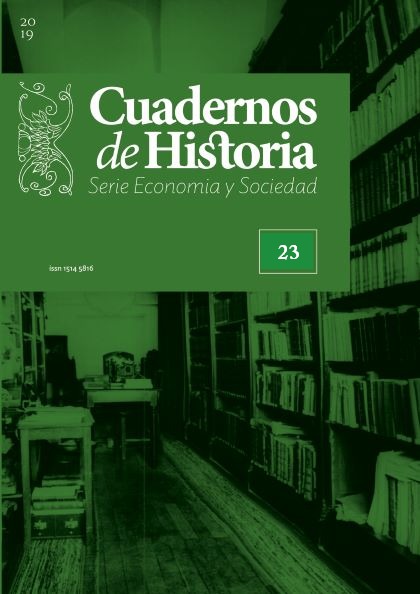The local key to the protest: resistance and repression against the closure of sugar mills, Villa Quinteros (Tucumán)
DOI:
https://doi.org/10.53872/2422.7544.n23.27295Keywords:
social protest - sugar crisis - local perspectiveAbstract
The article analyzes the social conflict in the towns of Tucumán in the face of the closure of sugar mills in the mid-1960s. To that end, the text explores the protests in the town of Villa Quinteros that originated after the closure of the local factory in 1967. Explaining the protests in the sugarcane villages involves reconstructing the characteristics of each community, examining the trajectories of the actors involved and replenishing the profiles of those who occupied leadership spaces. In this way, we seek to offer an interpretation of the functions performed by the neighbourhood commissions, the workers' union and the parish priest based on an analysis that recovers the complexity of the local dynamic.
References
Barral, M. E. 2016, Curas con los pies en la tierra. Una historia de la Iglesia en la Argentina contada desde abajo, Sudamericana, Buenos Aires.
Bravo, M. C. (coord.) 2017, La agricultura: actores, expresiones corporativas y políticas, Imago Mundi, Buenos Aires.
Bravo, M. C. & Bustelo, J. 2018, “Conflictos interregionales y política azucarera argentina. Los sectores productivos entre el peronismo y la Revolución Libertadora (1950-1957) en Anuario IHES, 33, 1, pp. 61 a 85.
Bustelo, J. 2016, “Los ingenios mixtos en Tucumán durante el primer peronismo (1943-1955)” en H-industri@. Revista de la historia de la industria, los servicios y las empresas en América Latina, X, 19. Disponible en: http://ojs.econ.uba.ar/ojs/index.php/H-ind/issue/view/147.
Crenzel, E. 1997, El Tucumanazo, Universidad Nacional de Tucumán, Tucumán.
Gutiérrez, F. 2014, “La irrupción del poder obrero en los ingenios azucareros: avances, límites y cuestionamientos. Tucumán, 1944-1949” en Quinto Sol, 18.
Kotler, R. 2012, “Villa Quinteros se rebela: El Tucumanazo del ‘69 y la lucha contra el cierre de los ingenios” en Historia, Voces y Memoria, 4.
Martín, J. P. 2013, Ruptura ideológica del catolicismo argentino. 36 entrevistas entre 1988 y 1992, Prometeo/ Universidad Nacional de General Sarmiento, Buenos Aires.
Nassif, S. 2016, Tucumán en llamas. El cierre de los ingenios y la lucha obrera contra la dictadura, Facultad de Filosofía y Letras, Tucumán.
Nassif, S. 2012, Tucumanazos. Una huella histórica de luchas populares 1969-1972, Instituto de Investigaciones Históricas” Dr. Ramón Leoni Pinto”, Tucumán.
Pucci, R. 2007, Historia de la destrucción de una provincia, Tucumán 1966, Ediciones del Pago Chico, Tucumán.
Romano, G. 2008, Benito, azúcar y sangre, Ed. de autor, Buenos Aires.
Rosales, M. del C. 2017, “La salud como derecho ciudadano. Las políticas de salud en Tucumán durante el primer peronismo (1943-1955)” en Fernández, M. E. (coord.) La salud: instituciones, espacios y actores, Imago Mundi, Buenos Aires, pp. 81 a 114.
Sánchez, I. 2019, “Entre la villa y la fábrica. El pueblo de Santa Ana en la especialización azucarera tucumana de fines del siglo XIX” en Travesía, 21, 1, pp.117 a 150.
Schkolnik, I. 2014, “La Diócesis de la Santísima Concepción. Entre la renovación conciliar y los conflictos sociales” en Amenta, S. (coord.) Aportes para la historia de la Diócesis de Concepción, UNSTA, Tucumán.
Schkolnik, I. 2012, “Las recepciones del Concilio Vaticano II en Tucumán, 1965-1973” en Itinerantes. Revista de Historia y Religión, 2, pp. 123 a 139.
Taylor, W. 2003, Entre el proceso global y el conocimiento local. Ensayos sobre el Estado, la sociedad y la cultura en el México del Siglo XVIII, UAM-Miguel Angel Porrúa, México.
Torre, A. 2018, “Micro/macro: ¿local/global? El problema de la localidad en una historia espacializada” en Historia Crítica, 69, pp. 37 a 67.
Downloads
Published
Issue
Section
License

This work is licensed under a Creative Commons Attribution 4.0 International License.
Authors publishing in this journal accept the following terms:
a. The author maintains their copyrights and grants this journal the publication of the first original version of their work that is subject to the Creative Commons Attribution License 4.0. This license agreement allows:
Sharing — copy and redistribution of the published material by any means and formats
Reusing — remix, change, and creation of new material from the published work for any purpose, including commercial use.
b. Authors may enter other non-exclusive license agreements of distribution of the version of the published work (i.e. uploading the material on an institutional virtual archive or republishing it on a monographic volume) as long as they attribute the publication of the original version to this journal.
c. It is allowed and recommended that authors publicize their work on the Internet (i.e. on institutional virtual archives or on their personal or professional websites) after their work has been published in this journal.




